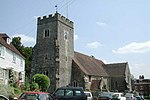Bourne Alder Carr
Sites of Special Scientific Interest in Kent

Bourne Alder Carr is a 13.4-hectare (33-acre) biological Site of Special Scientific Interest east of Sevenoaks in Kent.The River Bourne runs through a shallow valley, and frequent flushing of the woodland on the banks with water rich in nutrients creates a rich ground flora. There is also an area of swamp around a fish pond.Roads and footpaths go through this site.
Excerpt from the Wikipedia article Bourne Alder Carr (License: CC BY-SA 3.0, Authors, Images).Bourne Alder Carr
Winfield Lane, Tonbridge and Malling Plaxtol
Geographical coordinates (GPS) Address Nearby Places Show on map
Geographical coordinates (GPS)
| Latitude | Longitude |
|---|---|
| N 51.271 ° | E 0.301 ° |
Address
Winfield Lane
Winfield Lane
TN15 0LZ Tonbridge and Malling, Plaxtol
England, United Kingdom
Open on Google Maps







